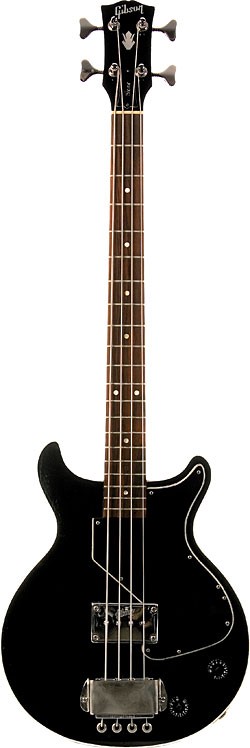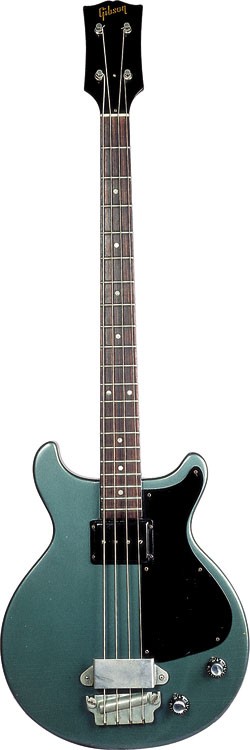
A ca. 1960 Gibson EB-0 that once belonged to Kiss bassist Gene Simmons. Photo: VG Archive.
In the mid 1970s, Kiss bassist Gene Simmons played this heavily reworked second-generation Gibson EB-0 on television shows like “Don Kirshner’s Rock Concert” and a Paul Lynde Halloween special.
Gibson entered the solidbody bass market in 1953 with the Electric Bass (“Bass Space,” February ’06), a violin-shaped short-scale (30½”) designed to challenge Fender’s 34″-scale Precision. Apparently, it proved too stodgy, as Gibson shipped a total of only 546 units before the model was phased out in 1958. The EB-0 then debuted in ’59 with a mahogany double-cutaway body with a silhouette inspired by second-generation Les Paul Juniors, Specials, and TVs (which were also introduced in the late ’50s). The company introduced another electric bass that year – the semi-solid EB-2 (companion to the ES-335) – and launched another solidbody bass in ’59. Both the EB-2 and the new EB-0 had a 30½” scale.
While those models had necks that allowed full access to all frets, the EB-0 had a one-piece 20-fret mahogany neck that joined the body at the 17th fret. The neck was topped with a rosewood fingerboard, and the instruments had a Cherry Red finish, a black plastic-covered humbucking pickup located near the neck joint, a single-ply black plastic pickguard, and a simple bridge/tailpiece unit. The original version had rear-projecting, banjo-style tuners (as did the Electric Bass), but right-angle tuners became standard shortly before the design of the EB-0 was transitioned to a pointed-double-cutaway body in early 1961.
To describe this particular EB-0 as “modified” would be an understatement. It has been refinished, the top edge of the body sports white binding, it has a replacement pickguard, and a circa 1970 replacement Gibson humbucking pickup embossed with the company name. The pickup has been moved closer to the bridge, even beyond where Gibson moved it to in the early ’70s.

An original 1960 Gibson EB-0 in Pelham Blue. Photo: Bill Ingalls, Jr., instrument courtesy of Wes Bentley.
The bridge/tailpiece area has also been considerably reworked. Underneath the handrest is a Leo Quan Badass bridge, and the strings now load from the rear, through non-original ferrules. And if anything inarguably ties the instrument to Simmons, it’s the handrest cover over the bridge, with its noticeable triangular patch of wear on the cover. At least one archival photo of Simmons shows him thonking this bass with the wear clearly visible.
Curiously, this bass was apparently prepared for further modifications that never happened. There’s a diagonal slice in the custom-made pickguard, near the corner of the fretboard, and a couple extra screws have been installed. Removing the pickguard reveals that a portion of the body has been routed, though there is no sign of any manipulation of its electronics. Early photos of Simmons with the EB-0 don’t show the slice in the pickguard.
In terms of the history and collectibility of this guitar, there are a couple of points to address. First, it would make sense that the bass was modified and later used by Simmons more because of its looks, since Kiss placed heavy emphasis on the visual elements of everything it did – the color-based modifications offer obvious contrast, its short scale and smaller body would have contributed to the larger-than-life stature pursued by a guy wearing a bat suit and 7″-platform shoes, and Simmons obviously could have bought any basses his heart desired, and thus wouldn’t have given a second thought to modifying this axe.
Moreover, this EB-0 is, due to its extensive modifications, an example of an instrument that would be more collectible because of its celebrity association rather than its significance as an innovative instrument or its classic tone. And celebrity or not, the owner of any instrument is free to modify it. Might not seem fair, but when it comes to collecting guitars, it comes with the territory.
This article originally appeared in VG‘s Jan. 2007 issue. All copyrights are by the author and Vintage Guitar magazine. Unauthorized replication or use is strictly prohibited.



